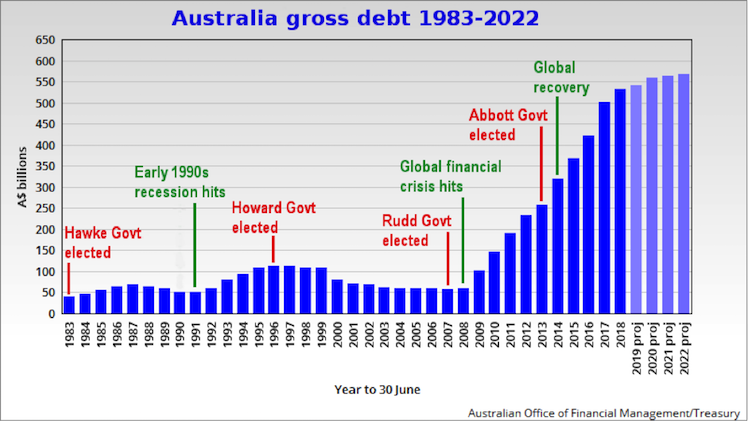Australia is falling behind other countries on a range of economic metrics. Alan Austin reports on Budget 2019 and the country’s performance against its global peers.
BURIED AT the end of Tuesday’s Budget papers are 18 pages of tables with numbers going back to 1971. Therein lies a wealth of data revealing the disastrous impact Coalition policies have had on Australia’s economy.
We see, for instance, that gross debt rose from 16.8 per cent of gross domestic product (GDP) in 2013, to a thumping 28.8 per cent last June.
This is the key area in which the Coalition and its mainstream media cheer squad still try to condemn Labor. Treasurer Josh Frydenberg twice in Tuesday’s budget speech referred disparagingly to “Labor’s debt”. They want voters to think it was Labor who irresponsibly sent the nation into debt — which it has taken the courageous Coalition nearly six years to reverse.
But here’s the thing. This debt to GDP table tells us nothing about the actual performance of the two administrations. That is because it does not reflect the prevailing economic conditions. What we need to do – using global data readily available – is see where Australia ranked in the world in 2007 when Labor came to office, where it ranked when Labor lost office in 2013 and where it stands now. Let’s do it.
Gross debt to GDP
Australia’s gross debt at the 2007 election was 4.9 per cent of GDP. That was the third lowest in the Organisation for Economic Cooperation and Development (OECD), the club of 36 wealthy, developed economies. Only Estonia and Chile carried less. A year later, after Wayne Swan had brought home the highest surplus in Australia’s history at $19.8 billion, Australia’s gross debt was down to 4.7 per cent of GDP, bettered only by Estonia on 4.5 per cent.
Then came the global financial crisis – the worst recession in 80 years – when all OECD countries were obliged to borrow extensively to pay for stimulus measures to keep their economies ticking over. Australia acted fastest and with the greatest initial quantum — a staggering $51.9 billion in outlays. But it worked.
By 2013, Australia’s debt had risen to 16.8 per cent. That was still third lowest in the OECD with only Chile and Estonia marginally lower.
Fast forward to now. What has happened between 2013 and 2018? Of the 36 OECD countries, 18 have reduced their gross debt, two of them by more than 40 per cent of GDP. Another 12 have increased the debt by less than five per cent. Only three have increased it by more than ten per cent of GDP. Of these poorly managed economies – Australia, Mexico and Chile – Australia’s blow-out has been the highest, at a thumping 11.6 per cent of GDP.
Australia’s gross debt is still low in actual dollars, at $534 billion last Friday. But that now ranks ninth in the OECD — down from third in 2013.
We can make similar comparisons for all the other critical variables to see how far Australia’s fortunes have fallen under the Coalition.

Australian Gross Debt 1983-2022
Jobless rate
In September 2013, the jobless rate was 5.7 per cent. That ranked sixth in the OECD. Then came the global boom in investment, growth, jobs and corporate profits. But while most countries enjoyed a dramatic fall in their jobless rates, Australia’s limped down to 4.9 per cent painfully slowly. This now ranks a lowly 17th.
Australia still has 664,000 people unemployed and more than one million underemployed. Consider what the jobless numbers would have been had Australia participated in the recent global boom and still ranked sixth in the OECD. The jobless rate would be 3.3 per cent and people unemployed would be down to 447,000. Another 217,000 workers would have a job and a much better life contributing to the community.
Economic growth
The quarterly growth in gross domestic product (GDP) for the 2018 December quarter was a dismal 0.18 per cent. This ranked 74th out of the 92 countries which record quarterly growth, and an appalling 30th out of the 36 OECD members.
Annual GDP growth – a more useful measure, as it removes short-term fluctuations –was 2.34 per cent for 2018. This ranked 112th out of 183 countries in the world, and 19th out of the 36 OECD members. These are Australia’s lowest rankings ever.
Through most of the Labor years, Australia was in the top six OECD countries by annual GDP growth and was a clear first back in 2009.
Hence both elements of the Coalition incessant mantra of “jobs and growth” demonstrate comprehensively the failure of the Coalition to keep the economy among the world’s leaders.
The other critical rankings within the OECD can be summarised under two headings. (Data is from tradingeconomics.com, the IMF and Credit Suisse.)
Coalition doubles all government debt since Federation in just under six years
Household wealth and income
Rate of annual wage rises: down from seventh in 2013 to 21st now.
Gross domestic product per capita: down from fifth to seventh.
Gross national savings: down from ninth to 19th.
Mean wealth per adult: down from second to fourth.
Household debt: up from the fourth highest to the second highest.
Gini coefficient (equality of wealth distribution): down from 12th to 28th.
Government and business measures
Budget deficit as a percentage of GDP: down from ninth to 25th;
Government spending as a percentage of GDP: down from fifth to eighth;
Growth in the volume of exports of goods and services: down from fourth to 18th.
Heritage Foundation economic freedom: down from first to third.
Value of the Australian dollar: down from 92 U.S. cents to 71.1 cents.
Value of the Australian dollar: down from 91.3 Japanese yen to 79.3 yen.
Value of the Australian dollar: down from 116 Kiwi cents to 105 cents.
There are probably only two significant variables on which Australia has improved relative to the rest of the world since 2013 — executive salaries and corporate profits. This explains why this analysis will not be found in Australia’s mainstream media.
——————–

Alan Austin
Alan Austin is a freelance journalist with interests in news media, religious affairs and economic and social issues.
You can follow Alan on Twitter @alanaustin001 .
Look Over There! How Josh Frydenberg’s Budget tricked the media
Public support is vital so this website can continue to fund investigations and publish stories which speak truth to power. Please subscribe for the free newsletter, share stories on social media and, if you can afford it, tip in $5 a month.
Alan Austin is a freelance journalist with interests in news media, religious affairs and economic and social issues.

